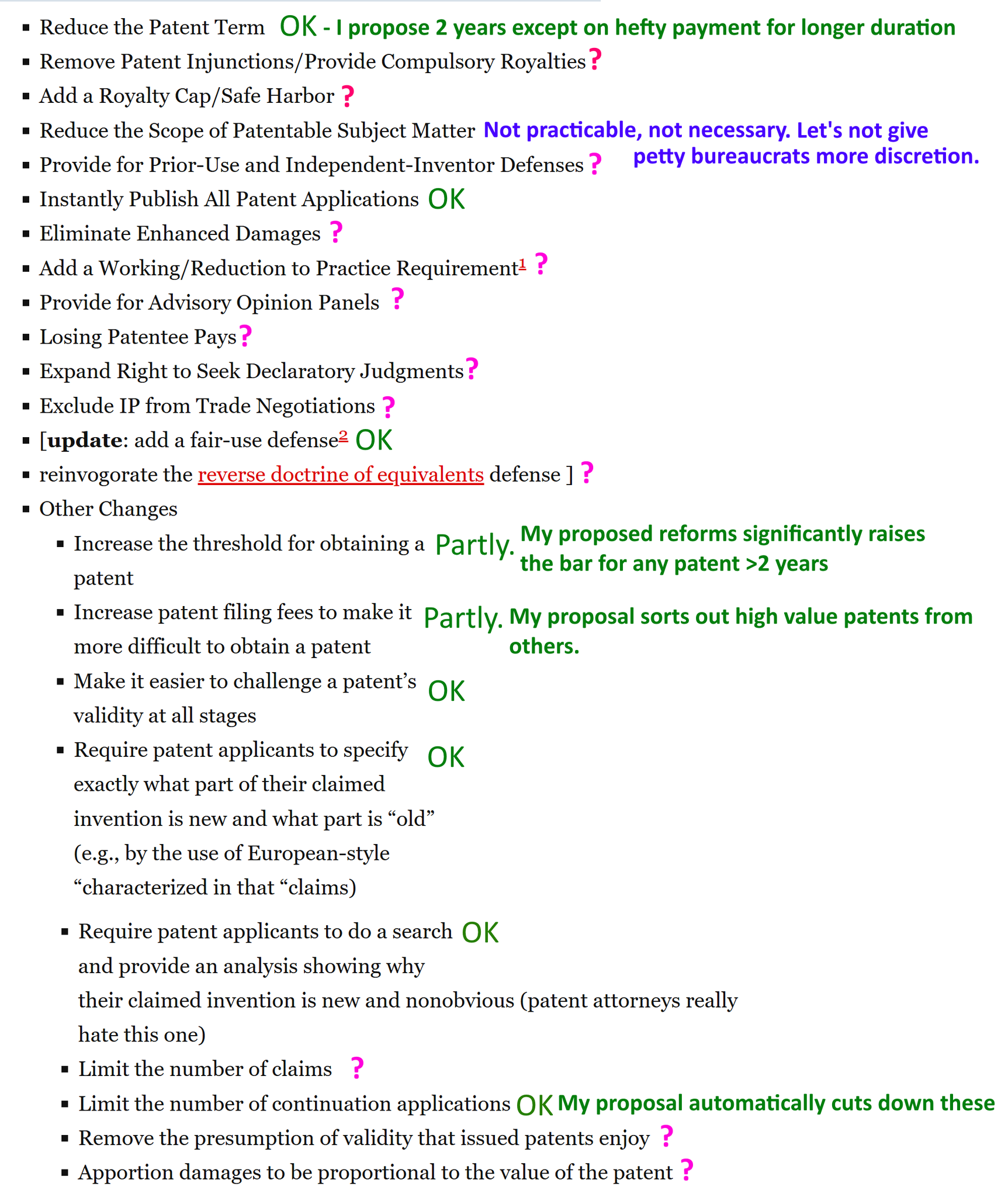Kinsella on Liberty Podcast: Episode 466.
Re
.@NSKinsella has proposed a number of patent reforms if we decide as a society not to abolish the patent system. This is, in my view, a more plausible way forward (politically) instead of demanding the abolition of patents.https://t.co/q3a0U2HQJ6
In this annotated extract, I… https://t.co/Jm36N2kjxa pic.twitter.com/Fs1caiVven
— Sanjeev Sabhlok (@sabhlok) June 4, 2025
Sabhlok’s markup of my proposals:

See How to Improve Patent, Copyright, and Trademark Law and “Reducing the Cost of IP Law,” Mises Daily (2010). See also Tabarrok’s Launching the Innovation Renaissance: Statism, not renaissance
How to Improve Patent, Copyright, and Trademark Law
[From my Webnote series]
This is included as ch. 41 of Stephan Kinsella, ed., The Anti-IP Reader: Free Market Critiques of Intellectual Property (Papinian Press, 2023).
See also proposals for reform in “Reducing the Cost of IP Law”; also Do Business Without Intellectual Property (Liberty.me, 2014); KOL164 | Obama’s Patent Reform: Improvement or Continuing Calamity?: Mises Academy (2011). And FDA and Patent Reform: A Modest Proposal
***
From my Mises blog post a year ago:
How to Improve Patent, Copyright, and Trademark Law
Archived comments (below)
January 13, 2010 by Stephan Kinsella
As I note in my article “Radical Patent Reform Is Not on the Way,” Mises Daily (Oct. 1, 2009), there is a growing clamor for reform of patent (and copyright) law, due to the increasingly obvious injustices resulting from these intellectual property (IP) laws. However, the various recent proposals for reform merely tinker with details and leave the essential features of the patent system intact. Patent scope, terms, and penalties would still be essentially the same. In the second article of this two-part series, “Reducing the Cost of IP Law,” Mises Daily, published today, I propose various reforms to the existing patent system–short of abolition–that would significantly reduce the costs and harm imposed by the patent system while not appreciably, or as significantly, reducing the innovation incentives and other purported benefits of the patent system. I list these changes below in generally descending order of importance, without elaboration, as they are discussed further in “Reducing the Cost of IP Law”:
Patent Law
- Reduce the Patent Term
- Remove Patent Injunctions/Provide Compulsory Royalties
- Add a Royalty Cap/Safe Harbor
- Reduce the Scope of Patentable Subject Matter
- Provide for Prior-Use and Independent-Inventor Defenses
- Instantly Publish All Patent Applications
- Eliminate Enhanced Damages
- Add a Working/Reduction to Practice Requirement1
- Provide for Advisory Opinion Panels
- Losing Patentee Pays
- Expand Right to Seek Declaratory Judgments
- Exclude IP from Trade Negotiations
- [update: add a fair-use defense2
- reinvogorate the reverse doctrine of equivalents defense ]
- Other Changes
 Increase the threshold for obtaining a patent
Increase the threshold for obtaining a patent- Increase patent filing fees to make it more difficult to obtain a patent
- Make it easier to challenge a patent’s validity at all stages
- Require patent applicants to specify exactly what part of their claimed invention is new and what part is “old” (e.g., by the use of European-style “characterized in that “claims)
- Require patent applicants to do a search and provide an analysis showing why their claimed invention is new and nonobvious (patent attorneys really hate this one)
- Limit the number of claims
- Limit the number of continuation applications
- Remove the presumption of validity that issued patents enjoy—e.g. a utility model or “petty patent” system, in which patent applications are examined only minimally and receive narrower protection; this type of IP right is already available in some countries) 1
- Apportion damages to be proportional to the value of the patent
Copyright
- update: First Amendment Defense Act of 2021
- Radically reduce the term, from life plus 70 years to, say, 10 years
- Remove software from copyright coverage (it’s functional, not expressive)
- Require active registration and periodic re-registration (for a modest fee) and copyright notice to maintain copyright (today it is automatic, and it is often impossible to determine, much less locate, the owner), or otherwise make it easier to use “orphaned works“
- Provide an easy way to dedicate works to the public domain — to abandon the copyright the state grants authors
- Eliminate manifestly unjust provisions of the Digital Millennium Copyright Act (DMCA), such as its criminalization of technology that can be used to circumvent digital protection systems
- Expand the “fair use” defense and clarify it to remove ambiguity
- Provide that incidental use (e.g., buildings or sculptures appearing in the background of films) is fair use
- Reduce statutory damages
- Note: Because some of these changes would violate the Berne Convention, the US should exit this and any other relevant treaty3
Trademark
- Raise the bar for proving “consumer confusion”
- Abolish “antidilution” protection
- In fact, abolish the entire federal trademark law, as it is unconstitutional (the Constitution authorizes Congress to enact copyright and patent laws, but not trademark law)
***
Podcast (kinsella-on-liberty): Play in new window | Download (18.0MB)












Recent Comments